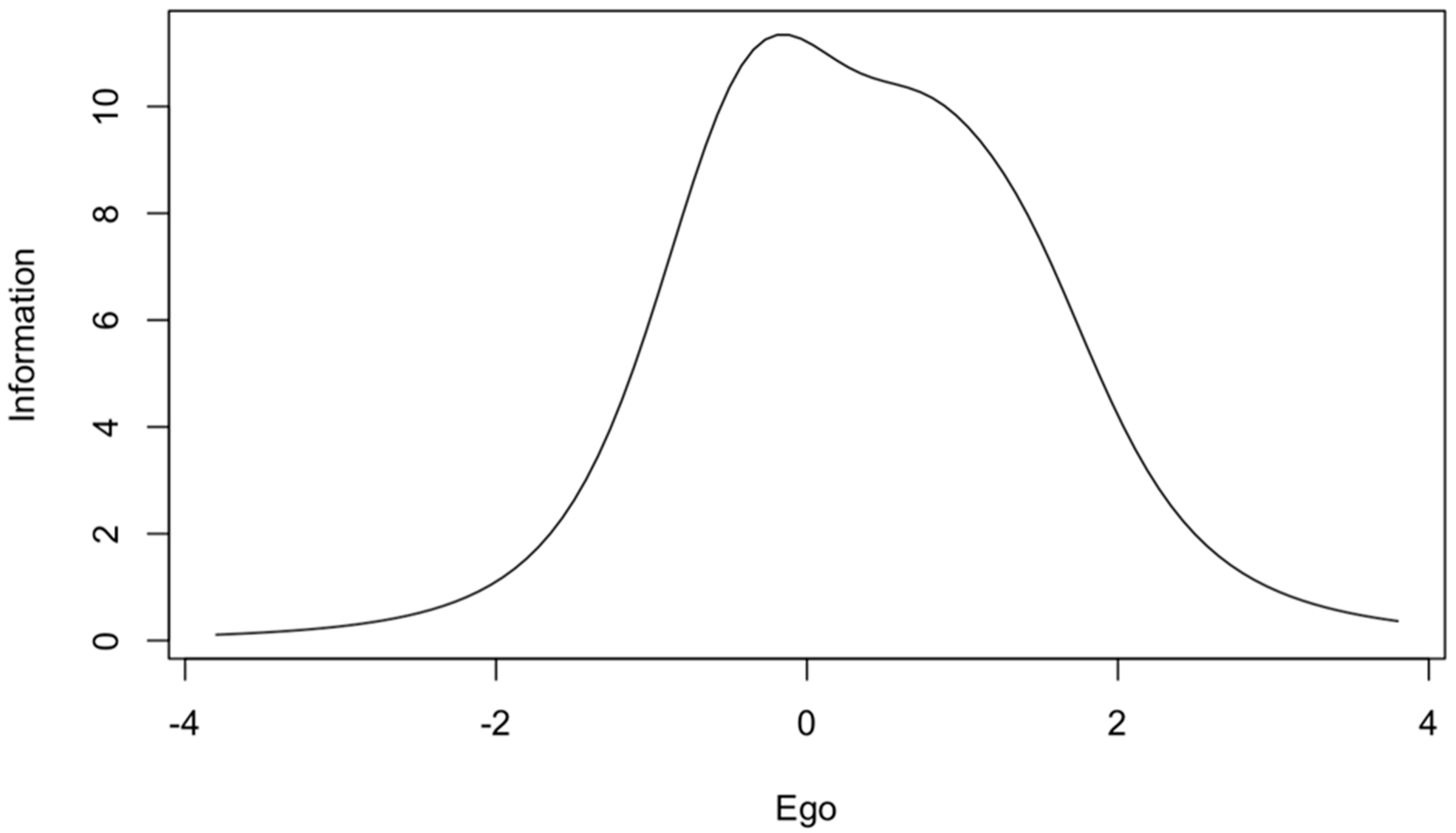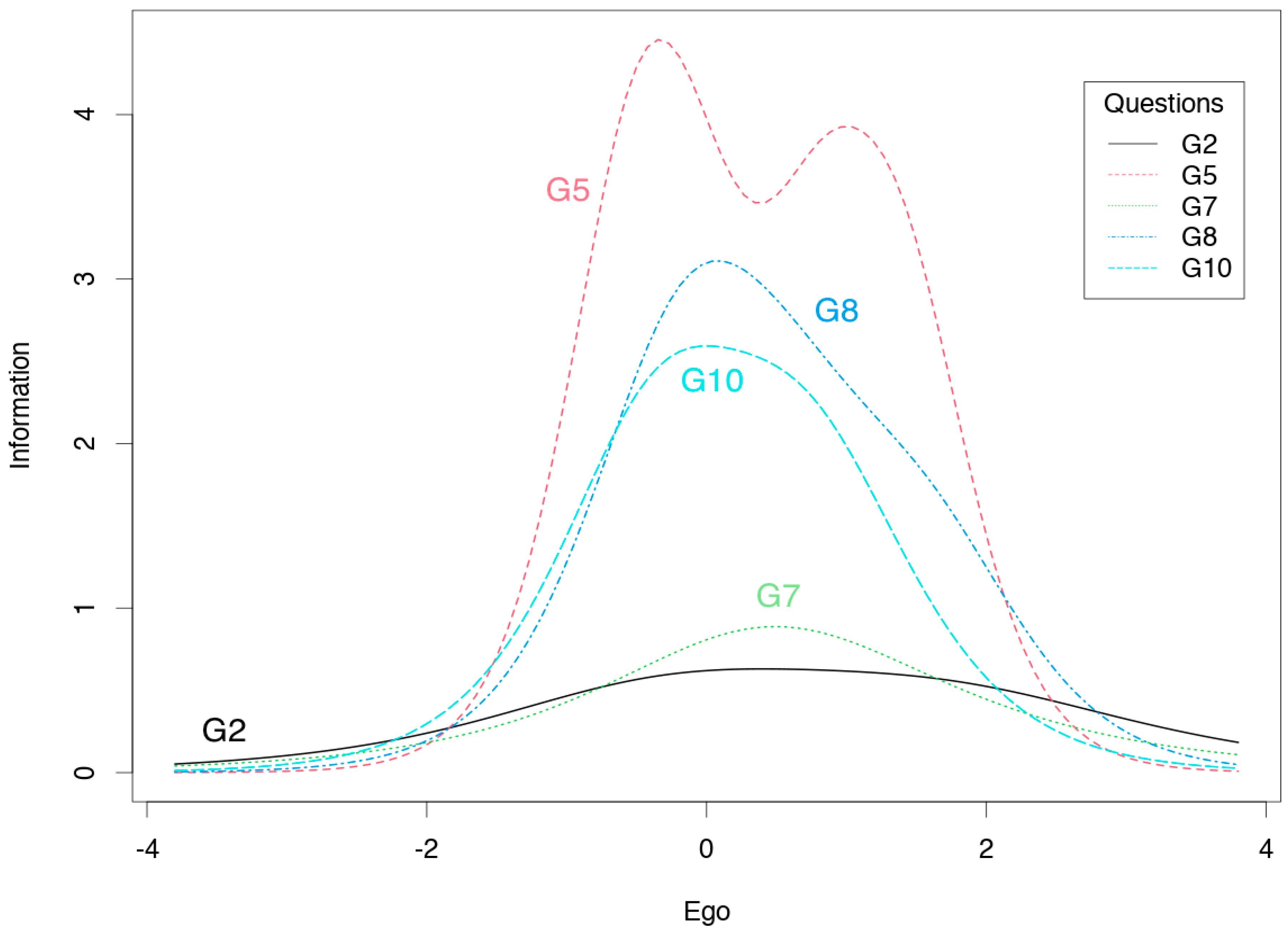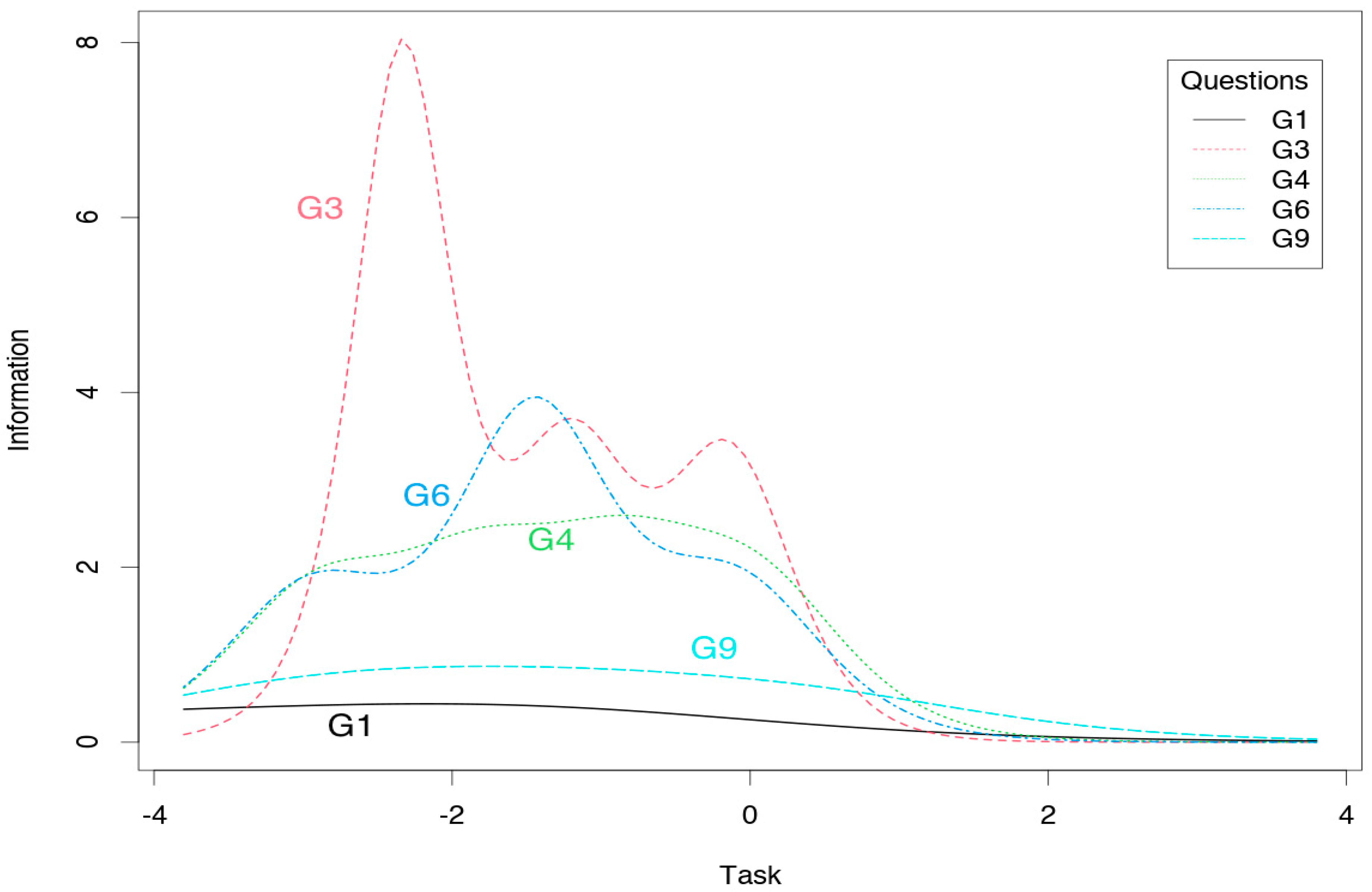Goal Orientation and Physical Activity: Psychometric Properties of the Polish Version of the Goal Orientation in Exercise Measure (GOEM)
Abstract
1. Introduction
2. Material and Methods
2.1. Study Subjects
2.2. Research Methods
2.3. Statistical Analysis
3. Results
3.1. Confirmatory Factor Analysis (CFA)
3.2. Invariance by Gender
3.3. Reliability of the GOEM Scale—Cronbach Alpha, McDonald Omega and Test-Retest Correlation
3.4. Reliability of Items—IRT Model Used
3.5. Relations of the Goal Orientation with Physical Activity Components
4. Discussion
Author Contributions
Funding
Institutional Review Board Statement
Informed Consent Statement
Data Availability Statement
Conflicts of Interest
References
- Stamatakis, E.; Gale, J.; Bauman, A.; Ekelund, U.; Hamer, M.; Ding, D. Sitting time, physical activity, and risk of mortality in adults. J. Am. Coll. Cardiol. 2019, 73, 2062–2072. [Google Scholar] [CrossRef]
- Moeijes, J.; Van Busschbach, J.T.; Bosscher, R.J.; Twisk, J.W.R. Sports participation and health-related quality of life: A longitudinal observational study in children. Qual. Life Res. 2019, 28, 2453–2469. [Google Scholar] [CrossRef] [PubMed]
- Gill, D.L.; Hammond, C.C.; Reifsteck, E.J.; Jehu, C.M.; Williams, R.A.; Adams, M.M.; Lange, E.H.; Becofsky, K.; Rodriguez, E.; Shang, Y.T. Physical activity and quality of life. J. Prev. Med. Public Health 2013, 46, 28–34. [Google Scholar] [CrossRef] [PubMed]
- Jenkin, C.R.; Eime, R.M.; Westerbeek, H.; O’Sullivan, G.; Van Uffelen, J.G.Z. Sport and ageing: A systematic review of the determinants and trends of participation in sport for older adults. BMC Public Health 2017, 17, 976. [Google Scholar] [CrossRef] [PubMed]
- Brunet, J.; Sabiston, C.M. Exploring motivation for physical activity across the adult lifespan. Psychol. Sport Exerc. 2011, 12, 99–105. [Google Scholar] [CrossRef]
- Wang, C.K.J.; Chatzisarantis, N.L.D.; Spray, C.M.; Biddle, S.J.H. Achievement goal profiles in school physical education: Differences in self-determination, sport ability beliefs, and physical activity. Br. J. Educ. Psychol. 2002, 72, 433–445. [Google Scholar] [CrossRef]
- Ahmed, D.; Ho, W.K.Y.; Van Niekerk, R.L.; Morris, T.; Elayaraja, M.; Lee, K.; Randles, E. The self-esteem, goal orientation, and health-related physical fitness of active and inactive adolescent students. Cogent Psychol. 2017, 4, 1331602. [Google Scholar] [CrossRef]
- Nicholls, J.G. Achievement motivation: Conceptions of ability, subjective experience, task choice, and performance. Psychol. Rev. 1984, 91, 328–346. [Google Scholar] [CrossRef]
- Duda, J.L. The relationship between task and ego orientation and the perceived purpose of sport among high school athletes. J. Sport Exerc. Psychol. 1989, 11, 318–335. [Google Scholar] [CrossRef]
- Duda, J.L.; Nicholls, J.G. Dimensions of achievement motivation in schoolwork and sport. J. Educ. Psychol. 1992, 84, 290–299. [Google Scholar] [CrossRef]
- Treasure, D.C.; Roberts, G.C. Perception of success questionnaire: Preliminary validation in an adolescent population. Percept. Mot. Ski. 1994, 79, 607–610. [Google Scholar] [CrossRef]
- Roberts, G.C.; Treasure, D.C.; Balague, G. Achievement goals in sport: The development and validation of the perceptions of success questionnaire. J. Sports Sci. 1998, 16, 337–347. [Google Scholar] [CrossRef] [PubMed]
- Petherick, C.M.; Markland, D. The development of a goal orientation in exercise measure (GOEM). Meas. Phys. Educ. Exerc. Sci. 2008, 12, 55–71. [Google Scholar] [CrossRef]
- Tomczak, M.; Walczak, M.; Kleka, P.; Walczak, A.; Bojkowski, Ł. Psychometric properties of the polish version of task and ego orientation in sport questionnaire (TEOSQ). Int. J. Environ. Res. Public Health 2020, 17, 3593. [Google Scholar] [CrossRef] [PubMed]
- Tomczak, M.; Walczak, M.; Kleka, P.; Walczak, A.; Bojkowski, Ł. The measurement of goal orientation in sport: Psychometric properties of the polish version of the perception of success questionnaire (POSQ). Int. J. Environ. Res. Public Health 2020, 17, 6641. [Google Scholar] [CrossRef] [PubMed]
- Kilpatrick, M.; Bartholomew, J.; Riemer, H. The measurement of goal orientations in exercise. J. Sport Behav. 2003, 26, 121–136. [Google Scholar]
- Cid, L.; Rodrigues, F.; Teixeira, D.S.; Morales-Sánchez, V.; Macedo, R.; Monteiro, D. Examining achievement goals in exercisers: Adaptation and validation of the goal orientations in exercise measure (GOEM). Qual. Quant. 2021, 55, 621–636. [Google Scholar] [CrossRef]
- Ersöz, G.; Müftüler, M.; Yerlisu, L.T.; Adile, T. Reliability and validity of goal orientation in exercise measure (GOEM)—Turkish version. Cogent Educ. 2017, 4, 1283877. [Google Scholar] [CrossRef]
- Owen, K.B.; Smith, J.; Lubans, D.R.; Ng, J.Y.; Lonsdale, C. Self-determined motivation and physical activity in children and adolescents: A systematic review and meta-analysis. Prev. Med. 2014, 67, 270–279. [Google Scholar] [CrossRef]
- Festinger, L. A Theory of social comparison processes. Hum. Relat. 1954, 7, 117–140. [Google Scholar] [CrossRef]
- Markland, D.; Tobin, V. A modification to the behavioural regulation in exercise questionnaire to include an assessment of amotivation. J. Sport Exerc. Psychol. 2004, 26, 191–196. [Google Scholar] [CrossRef]
- Hu, L.T.; Bentler, P.M. Cutoff criteria for fit indexes in covariance structure analysis: Conventional criteria versus new alternatives. Struct. Equ. Model. 1999, 6, 1–55. [Google Scholar] [CrossRef]
- Whittaker, T.A. Structural equation modelling. In Applied Multivariate Statistics for the Social Sciences: Analyses with SAS and IBM’s SPSS; Pituch, K.A., Stevens, J.P., Eds.; Routledge: New York, NY, USA, 2016; pp. 639–733. [Google Scholar]
- Chen, F.F. Sensitivity of goodness of fit indexes to lack of measurement invariance. Struct. Equ. Model. A Multidiscip. J. 2007, 14, 464–504. [Google Scholar] [CrossRef]
- Rizopoulos, D. Itm: An R package for latent variable modelling and item response theory analyses. J. Stat. Softw. 2006, 17, 1–25. [Google Scholar] [CrossRef]
- DeMars, C. Item Response Theory; Oxford University Press (OUP): New York, NY, USA, 2010. [Google Scholar]
- Van Der Horst, K.; Paw, M.J.C.A.; Twisk, J.W.R.; Van Mechelen, W. A brief review on correlates of physical activity and sedentariness in youth. Med. Sci. Sports Exerc. 2007, 39, 1241–1250. [Google Scholar] [CrossRef] [PubMed]
- Gråstén, A.; Watt, A.P. Perceptions of motivational climate, goal orientations, and light- to vigorous-intensity physical activity engagement of a sample of finnish grade 5 to 9 students. Int. J. Exerc. Sci. 2016, 9, 25–36. [Google Scholar]
- Tzetzis, G.; Goudas, M.; Kourtessis, T.; Zisi, V. The relation of goal orientations to physical activity in physical education. Eur. Phys. Educ. Rev. 2002, 8, 177–188. [Google Scholar] [CrossRef]





| ML | Robust Values (S–B) | |
|---|---|---|
| Chi-sq | 99.880 | 91.699 |
| df | 34.000 | 34.000 |
| p value | 0.000 | 0.000 |
| CFI | 0.953 | 0.955 |
| TLI | 0.937 | 0.940 |
| NFI | 0.930 | 0.926 |
| RMSEA | 0.078 | 0.076 |
| RMSEA L.L. | 0.061 | 0.058 |
| RMSEA U.L. | 0.096 | 0.095 |
| Chi-Sq Scaled | df Scaled | p-Value Scaled | Robust CFI | Robust RMSEA | |
|---|---|---|---|---|---|
| Model 1. Configural | 126.708 | 68 | <0.001 | 0.954 | 0.076 |
| Model 2. Metric | 136.107 | 76 | <0.001 | 0.953 | 0.073 |
| Model 3. Scalar | 161.474 | 84 | <0.001 | 0.941 | 0.078 |
| Model 4. Scalar part | 147.130 | 82 | <0.001 | 0.950 | 0.073 |
| Model 5. Strict | 156.653 | 92 | <0.001 | 0.948 | 0.070 |
| Chisq | Df | ΔCFI * | ΔRMSEA * | ChiSqΔ (df) | p-Value | |
|---|---|---|---|---|---|---|
| Model 1. Configural | 136.470 | 68 | - | - | - | - |
| Model 2. Metric | 147.058 | 76 | 0.001 | 0.003 | 9.542 (8) | 0.2986 |
| Model 3. Scalar | 170.791 | 84 | 0.012 | 0.005 | 28.205 (8) | 0.0004 |
| Model 4. Scalar part | 157.121 | 82 | 0.003 | 0.000 | 11.072 (6) | 0.0861 |
| Model 5. Strict | 173.806 | 92 | 0.002 | 0.003 | 11.502 (10) | 0.3197 |
| Ego | Task | ||||
|---|---|---|---|---|---|
| ITEMS | Information (−4, 4) | Proportions of Information | ITEMS | Information (−4, 4) | Proportions of Information |
| G2 | 3.03 | 0.9278 | G1 | 2.03 | 0.7148 |
| G5 | 11.99 | 0.9999 | G3 | 13.87 | 0.9992 |
| G7 | 3.13 | 0.9547 | G4 | 9.76 | 0.9905 |
| G8 | 8.68 | 0.9984 | G6 | 10.02 | 0.9844 |
| G10 | 7.10 | 0.9979 | G9 | 4.47 | 0.8941 |
| Ego (Bootstrap 95% CI) | Task (Bootstrap 95% CI) | |
|---|---|---|
| Length of one exercise session in minutes | 0.08 (−0.0358, 0.1945) p = 0.153 | 0.21, (0.1111, 0.3037) p < 0.001 |
| Frequency of undertaking per week | 0.08, (−0.0284, 0.1912) p = 0.141 | 0.19, (0.0800, 0.2879) p < 0.001 |
| Exercise experience in months | 0.06, (−0.0485, 0.1739) p = 0.262 | 0.03, (−0.0943, 0.1387) p = 0.646 |
| n = 318 | R = 0.22, R2 = 0.047, Adj. R2 = 0.034, F(4.313) = 3.84, p < 0.0046 | ||||
|---|---|---|---|---|---|
| β (SE) | B (SE) | t (313) | p | Bootstrap 95% CI | |
| Intercept | 1.03 (1.05) | 0.98 | 0.3268 | −1.3122, 3.3509 | |
| Ego | 0.05 (0.06) | 0.07 (0.08) | 0.84 | 0.3986 | −0.0949, 0.2546 |
| Task | 0.19 (0.06) | 0.46 (0.14) | 3.33 | 0.0010 | 0.2059, 0.7252 |
| Gender | 0.08 (0.06) | 0.26 (0.17) | 1.49 | 0.1358 | −0.0759, 0.6019 |
| Age | 0.06 (0.06) | 0.04 (0.04) | 1.03 | 0.3014 | −0.0454, 0.1266 |
| n = 318 | R = 0.37, R2 = 0.136, Adj. R2 = 0.125, F(4.313) = 12.33, p < 0.0001 | ||||
|---|---|---|---|---|---|
| β (SE) | B (SE) | t (313) | p | Bootstrap 95% CI | |
| Intercept | 41.84 (18.62) | 2.25 | 0.0254 | 8.5161, 76.1003 | |
| Ego | −0.00 (0.05) | −0.01 (1.51) | −0.01 | 0.9918 | −3.1904, 3.1741 |
| Task | 0.22 (0.05) | 10.28 (2.43) | 4.22 | <0.0001 | 5.7140, 14.7587 |
| Gender | 0.29 (0.05) | 16.44 (3.06) | 5.37 | <0.0001 | 10.5725, 22.2988 |
| Age | −0.06 (0.05) | −0.73 (0.68) | −1.08 | 0.2829 | −2.0396, 0.5589 |
| n = 318 | R = 0.22, R2 = 0.051, Adj. R2 = 0.039, F(4.313) = 4.19, p < 0.0026 | ||||
|---|---|---|---|---|---|
| β (SE) | B (SE) | t (313) | p | Bootstrap 95% CI | |
| Intercept | −14.34 (37.14) | −0.39 | 0.6996 | −87.2995, 57.1926 | |
| Ego | 0.04 (0.06) | 2.11 (3.02) | 0.70 | 0.4858 | −3.7973, 8.0298 |
| Task | 0.04 (0.06) | 3.21 (4.86) | 0.66 | 0.5085 | −6.5072, 12.9181 |
| Gender | 0.19 (0.06) | 20.34 (6.11) | 3.33 | 0.0010 | 8.3682, 31.8158 |
| Age | 0.14 (0.06) | 3.43 (1.36) | 2.52 | 0.0121 | 0.6527, 6.4410 |
Publisher’s Note: MDPI stays neutral with regard to jurisdictional claims in published maps and institutional affiliations. |
© 2021 by the authors. Licensee MDPI, Basel, Switzerland. This article is an open access article distributed under the terms and conditions of the Creative Commons Attribution (CC BY) license (https://creativecommons.org/licenses/by/4.0/).
Share and Cite
Tomczak, M.; Kleka, P.; Walczak, A.; Bojkowski, Ł.; Walczak, M. Goal Orientation and Physical Activity: Psychometric Properties of the Polish Version of the Goal Orientation in Exercise Measure (GOEM). J. Clin. Med. 2021, 10, 1900. https://doi.org/10.3390/jcm10091900
Tomczak M, Kleka P, Walczak A, Bojkowski Ł, Walczak M. Goal Orientation and Physical Activity: Psychometric Properties of the Polish Version of the Goal Orientation in Exercise Measure (GOEM). Journal of Clinical Medicine. 2021; 10(9):1900. https://doi.org/10.3390/jcm10091900
Chicago/Turabian StyleTomczak, Maciej, Paweł Kleka, Aleksandra Walczak, Łukasz Bojkowski, and Małgorzata Walczak. 2021. "Goal Orientation and Physical Activity: Psychometric Properties of the Polish Version of the Goal Orientation in Exercise Measure (GOEM)" Journal of Clinical Medicine 10, no. 9: 1900. https://doi.org/10.3390/jcm10091900
APA StyleTomczak, M., Kleka, P., Walczak, A., Bojkowski, Ł., & Walczak, M. (2021). Goal Orientation and Physical Activity: Psychometric Properties of the Polish Version of the Goal Orientation in Exercise Measure (GOEM). Journal of Clinical Medicine, 10(9), 1900. https://doi.org/10.3390/jcm10091900






